The Complete Florida Starfish Identification Guide
Flordia is an excellent spot for snorkeling and diving. You can spot there many different species of marine animals when underwater. Starfish, or sea stars, are definitely one of the most popular and easiest animals to spot in shallow waters. Have you wondered if and which species of starfish can you spot in Florida? In this blog post, we’ll talk all about that but let’s begin with a quick answer:
In Florida, you can find many different starfish species such as Red Cushion Starfish, Nine-Armed Sea Star, Orange-Ridged Sea Star, Conical-Spined Sea Star, Common Comet Star, Forbes Sea Star, Gray Sea Star, and Two-Spined Sea Star.
However, this certainly doesn’t tell the whole story. Below I’ll explain how to identify each species, and where to find them. Furthermore, I’ll explain why starfish are in Flordia and if you can pick them up. Read on!
Flordia starfish species
Red Cushion Sea Star
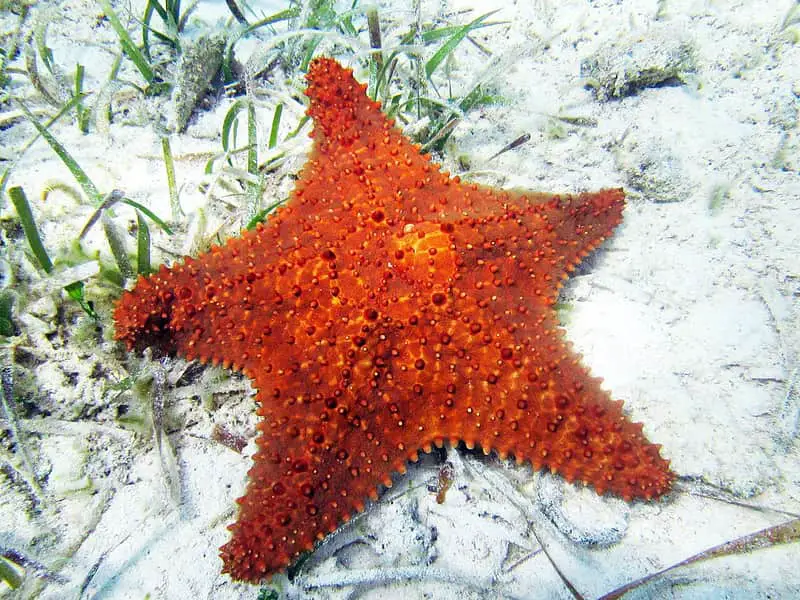
The Red Cushion Sea Star, or Bahama Sea Star, is the most abundant starfish in the Caribbean, including Flordia. They get the name from their inflated, pillow-like appearance. They have a thick and heavy body with five short arms, but some species can have four or six instead.
These sea stars’ color ranges from red to orangeish brown, and the pattern on their bodies looks like a geometric net system. Their size depends on their age and conditions but they can grow up to about 20 in (50 cm) in diameter.
Like all sea stars, they’re covered with short spines, but the red cushion sea stars have characteristic thick, round spines that are slightly lighter or darker than the rest of the body. They usually live on sandy bottoms, seagrass meadows, or coral reefs. Interestingly, the juvenile starfish are mostly greenish-brown, and the seagrass area coloring helps provide camouflage.
Other places to spot it: Shallow waters of the Western Central Atlantic Ocean such as the Bahamas, the Gulf of Mexico, Cape Frio, Cape Hatteras, Guyanas, most places in the Caribbean.
Nine-Armed Sea Star
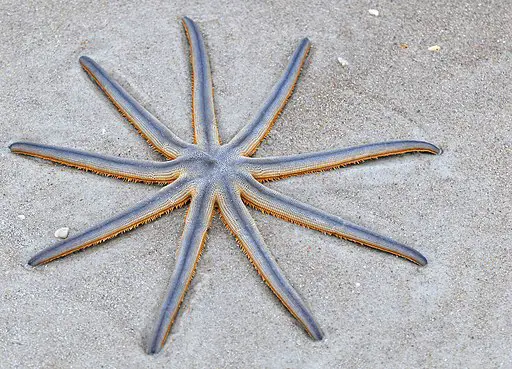
As the name suggests, Nine-Armed Sea Stars have nine slim, tapering long arms. Their upperside bodies’ color ranges from blueish grey to purple, but the underside of their bodies (where their feet are) is orange. They can grow to a diameter of about 12 to 16 in (30 to 40 cm). Like all sea stars, they’re covered with short spines, but their skin texture is much smoother than the red cushion sea stars.
Unlike most starfish, these species don’t have an anus that is normally located on the upper side of their body, close to the center. So instead, they expel undigested food fragments through their mouth located at the center of their oral side.
Another interesting fact about nine-armed starfish is that they don’t have suction cups at the end of their feet, like most sea star species. Starfish tube feet allow them to walk and breathe, and suction cups help them attach to the rocks or any other surfaces.
Because of the starfish habitat, the suction cups seem to be unnecessary. You can mostly spot nine-armed sea stars in sandy and muddy sheltered locations such as lagoons. They live in depts at depths up to 150 feet (46 m) and most of their time bury under the mud to hide from predators.
Other places to spot it: Coasts of the Caribbean Sea, the Gulf of Mexico, and along the coast of South America to southern Brazil.
Orange-Ridged Sea Star

Orange-Ridged Sea Star is also called Orange Sea star, and as the name says, their color ranges from bright orange to reddish. They have five long, round arms attached to the central disk, and their short spines create a kind of a granulated texture of their upper bodies.
Unlike the nine-armed sea star, they have suction cups and the end of their bright orange tube feet. The tips of their arms are usually slightly brighter than the rest of their bodies. Interestingly, this is where their eyes are located, which helps them find large, dark structures, like coral reefs.
These starfish species are medium-sized and can grow to about 6 inches (150 mm) in diameter. They mostly live on sandy bottoms, seagrass meadows, or coral reefs at depths between 33 and 66 ft (10 and 20 m).
Other places to spot it: The shallows of the western Atlantic ranging from Cape Hatteras and the Gulf Coast to Venezuela, the Caribbean Sea, and the Gulf of Mexico.
Conical-Spined Sea Star
Conical-spined sea stars have long, slightly tapered arms with rounded tips. They’re covered with characteristic, large, conical-like spines. Their color ranges from deep red to reddish-brown but some starfish can be also dark purple. Usually, their spines are orange-brown in color.
They typically live in warm and shallow waters at depths up to 50 ft (15 m). They prefer sandy sea floors, seagrass meadows, or rocky shores.
Other places to spot it: The Caribbean Sea, the coast of Belize
Common Comet Star
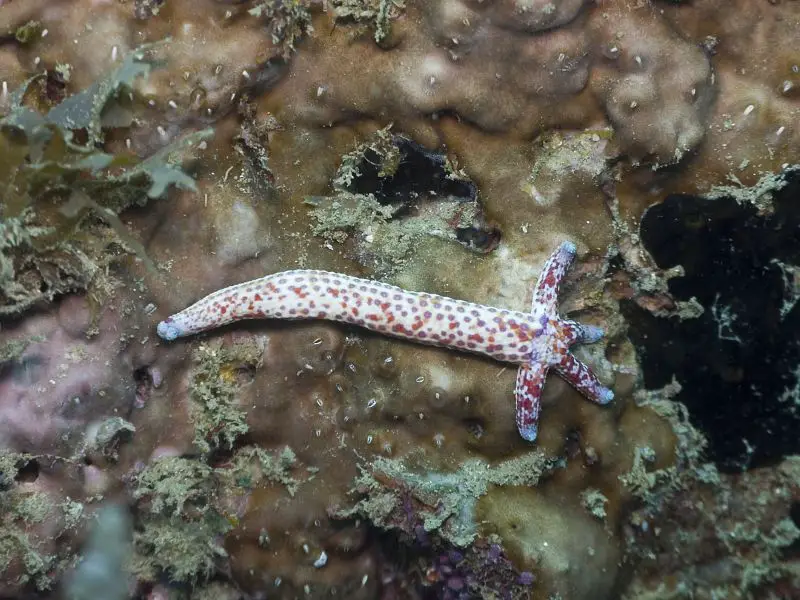
Common comet starfish have a pretty unique skill and, because of it – a characteristic look. They’re called “comets” because of their comet-like arm, which is bigger than the others because of asexual reproduction.
Starfish can reproduce asexually through body fission or by autotomy. In the common comet starfish case, the most common way is autonomy, which means they shed an arm with part of the central disc attached. The detached arm lives independently as a “comet” and eventually grows into a new individual.
Interestingly, almost all sea stars can regenerate their limbs, but only a few sea star species can reproduce in these ways. The reason for this behavior is not entirely known, but it could be a response to predators. You can read more about sexual and asexual reproduction in my other post: “How Are Starfish Born?”
Common comet starfish usually have five long arms but occasionally four or six. Their color varies a lot and can be shades of green, brown, blue, violet, and red. The individuals can grow to about 16 inches (40 cm) in diameter.
They usually inhabit shallow waters of about 3.2 ft (1 m) but have also been recorded at a depth of over 100 meters. These species prefer the hard, flat bottom coral reefs but can also inhabit sandy regions.
Other places to spot it: The east coast of the Americas from Flordia to Brazil and the Caribbean, Australia, and some other parts of tropical shallow waters.
Forbes Sea Star

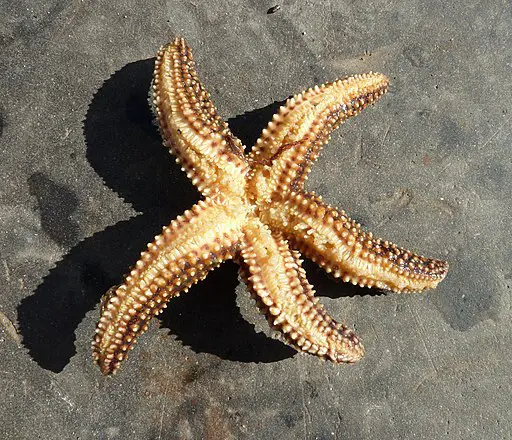
Like most starfish, Forbes sea stars usually have five arms but can also have four or six. Their upper surface is rough, covered in blunt conical spines slightly lighter in color than the rest of their bodies. Their upper body color can vary and ranges from brown or tan to reddish-purple, and the underside is usually pale brown-yellow.
Forbes sea stars’ arms are plump and broad, and the starfish can grow to about 5.9 in (15 cm) in diameter. Interestingly, this one prefers a little colder waters than the sea stars we discussed above. It’s still found in Flordia but mostly lives in the intertidal zone of rocky shores on the coast of North America.
Other places to spot it: Northwest Atlantic from Maine to the Gulf of Mexico.
Gray Sea Star
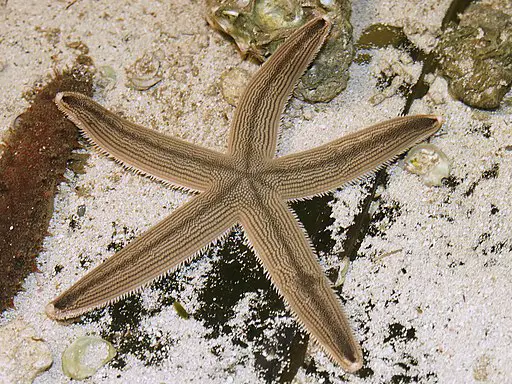
Gray sea stars or slender-armed sea stars are large and can grow to about 12 in (30 cm) in diameter. They have a small disk in the center and five large, characteristic flattened arms. As the name suggests, they’re gray in color but can also be light brown, and their oral side color ranges from pale yellow to light orange.
They have a characteristic central row of plates on the upper side of their arms, usually dark grey or black. They mostly live in places where their color works as a good camouflage which is sandy or muddy sea beds to a depth of 130 ft (40m).
Other places to spot it: The coast of the western Atlantic Ocean, from Virginia south to Brazil, the Gulf of Mexico, and the Caribbean Sea.
Two-Spined Sea Star
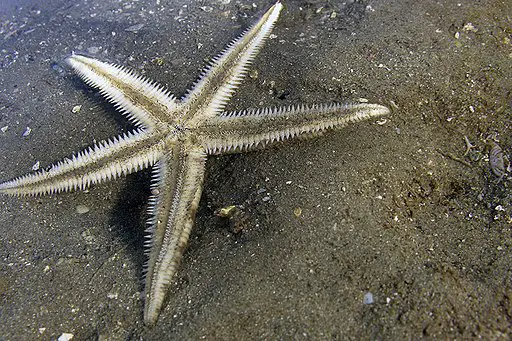
Two-Spined sea stars typically have five long slender and tapering arms that are flattened dorso-ventrally. The edges on the upper surface of their arms have a single row of large white marginal plates. Thanks to them, it’s usually very easy to recognize this sea star species.
These starfish can grow to about 8 in (20 cm) in diameter, and their color ranges from pale grey or reddish-brown, with the oral surface being pale brown or orange. Interestingly, these are another species without suckers at the end of their tube feet. They mostly live on sandy or seagrass bottoms at maximum depths of about 1,600 ft (500 m).
Other places to spot it: The eastern Atlantic Ocean, the Gulf of Mexico, and the Caribbean Sea.
Where can you spot starfish in Florida?
Florida has perfect conditions for many starfish species. Different species adapted to slightly different environments, so you can basically find them everywhere in Flordia. As saltwater species, they’re of course found in the ocean, so don’t search for them in the lakes.
To find starfish in Flordia, search the shallow waters by the shore. As I mentioned above, some starfish prefer sandy or seagrass meadows, so you can find them there. However, others inhabit rocky areas – especially calm tide pools and coral reefs. Look carefully because sometimes starfish hide under rocks, so you might accidentally miss them.
You can find them nearly on every snorkeling tour or snorkeling off the shore/beach.
Why starfish are in Florida?
Starfish are in Florida simply because of the great conditions. Starfish inhabit many different places such as rocky shores, tropical coral reefs, tidal pools, mud, sandy sea floors, and seagrass meadow and Flordia offers all of them. Additionally, many starfish species prefer tropical, shallow, and warm waters so Flordia is a paradise for them!
Can you pick starfish up?
Even though most starfish are not poisonous, you should never touch or pick them up. Starfish breathe through their skin by absorbing oxygen from the water. They can “hold their breath” for about 30 seconds or less. Removing them can simply cause them to suffocate and die.
Another reason not to touch them is that our skin oil or sunscreen can harm them and all sea creatures. We can transform the bacteria that they’re not immune to. Additionally, starfish can potentially feel stress and pain.
Sources
- Red Cushion Star Image: James St. John (photo provided by Miranda Manross) via Flickr
- Nine-Armed Sea Star Image: Andrea Westmoreland from DeLand, United States, CC BY-SA 2.0 https://creativecommons.org/licenses/by-sa/2.0, via Wikimedia Commons
- Orange Sea Star Image: NOAA, Public domain, via Wikimedia Commons
- Forbes Sea Star Image: Smithsonian Environmental Research Center, CC BY 2.0 https://creativecommons.org/licenses/by/2.0, via Wikimedia Commons and Paul Morris from USA, CC BY-SA 2.0 https://creativecommons.org/licenses/by-sa/2.0, via Wikimedia Commons
- Gray Sea Star Image: Hans Hillewaert via Wikimedia Commons
- Two-spined Sea Star Image: Vardhan Patankar, CC BY-SA 4.0 https://creativecommons.org/licenses/by-sa/4.0, via Wikimedia Commons
You may also like:

Welcome to Bubbly Diver!
I’m glad to see you here. This blog is created for all marine creature lovers by a bubbly diver - me, Dori :)


